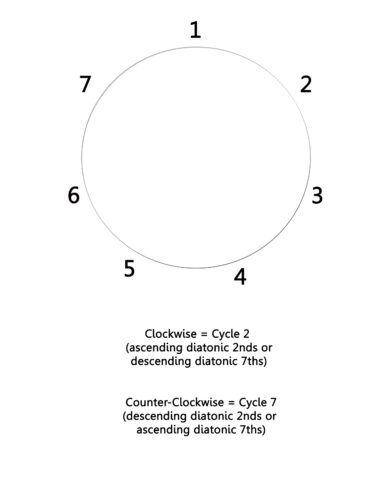This is the 1st of a 3 part lesson on using what I like to call a Cycle Wheel to deconstruct a scale. I first wrote about Cycle Wheels in the “Modern Jazz Vocabulary Vol.1” book on Harmonic Major. I’ve found this to be one of the most thorough and creative ways to work on all the ascending and descending intervals within an octave from any scale. Not only is this method organized it also allows for creativity and improvisation while working on all the intervals within a scale. In this first part we’ll look at the Clockwise Cycle 2 wheel (see the PDF below) and the Counter-Clockwise Cycle 7 wheel which will cover primarily 4 intervals.

I’ve found it challenging over the years to practice scales and still maintain an emphasis on creativity and improvisation. On one hand, patterns and specific shapes can be dry and often end up subordinating spontaneity and creativity to structure and content, while on the other hand, freely improvising from a scale or mode can lead to repetition and the accidental avoidance of certain intervals, shapes and melodies. Finding a creative way to improvise while still exploring all the possible intervals from within a given scale can be difficult, but I’ve found that using these cycle wheels to be quite beneficial in this regard.
Cycle 2 is simply ascending by diatonic step or descending by diatonic 7th within one scale – in this lesson, harmonic minor. For example; going from the note C to the note D either by ascending up a step or descending down by 7th.
Many interesting melodies can be created just from just one clockwise and counter clockwise cycle wheel. Simply put, this one wheel includes every ascending and descending diatonic 2nd (and diatonic 9ths, although this is more than an octave and we’ll stay within an octave for this lesson) and every descending and ascending diatonic 7th – these are 4 of the possible intervals found within any scale withing an octave. In the next 2 lessons we’ll look at the other 2 cycle wheels (3 – 6, and 4 – 5) that will complete every interval within an octave from any scale.
Lastly, practice improvising using the Cycle 2 Wheel (clockwise) and Cycle 7 Wheel (counter-clockwise) over a drone, a pedal or the roots and rhythm play-along.
Also using the 7 different roots from each mode of the concert C harmonic minor scale (C, D, Eb, F, G, Ab, B) will give you the 7 most common contexts for the melodies created from cycle 2 and 7 in this lesson.
To Support the Blog Visit The Store
Use the Blank Cycle Wheel to fill in any 7 note scale to create any cycle you’d like. This works well for synthetic scales like 7 note diminished or Hungarian minor.
